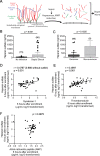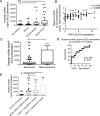Intravenous fluid resuscitation is associated with septic endothelial glycocalyx degradation
- PMID: 31337421
- PMCID: PMC6652002
- DOI: 10.1186/s13054-019-2534-2
Intravenous fluid resuscitation is associated with septic endothelial glycocalyx degradation
Abstract
Background: Intravenous fluids, an essential component of sepsis resuscitation, may paradoxically worsen outcomes by exacerbating endothelial injury. Preclinical models suggest that fluid resuscitation degrades the endothelial glycocalyx, a heparan sulfate-enriched structure necessary for vascular homeostasis. We hypothesized that endothelial glycocalyx degradation is associated with the volume of intravenous fluids administered during early sepsis resuscitation.
Methods: We used mass spectrometry to measure plasma heparan sulfate (a highly sensitive and specific index of systemic endothelial glycocalyx degradation) after 6 h of intravenous fluids in 56 septic shock patients, at presentation and after 24 h of intravenous fluids in 100 sepsis patients, and in two groups of non-infected patients. We compared plasma heparan sulfate concentrations between sepsis and non-sepsis patients, as well as between sepsis survivors and sepsis non-survivors. We used multivariable linear regression to model the association between volume of intravenous fluids and changes in plasma heparan sulfate.
Results: Consistent with previous studies, median plasma heparan sulfate was elevated in septic shock patients (118 [IQR, 113-341] ng/ml 6 h after presentation) compared to non-infected controls (61 [45-79] ng/ml), as well as in a second cohort of sepsis patients (283 [155-584] ng/ml) at emergency department presentation) compared to controls (177 [144-262] ng/ml). In the larger sepsis cohort, heparan sulfate predicted in-hospital mortality. In both cohorts, multivariable linear regression adjusting for age and severity of illness demonstrated a significant association between volume of intravenous fluids administered during resuscitation and plasma heparan sulfate. In the second cohort, independent of disease severity and age, each 1 l of intravenous fluids administered was associated with a 200 ng/ml increase in circulating heparan sulfate (p = 0.006) at 24 h after enrollment.
Conclusions: Glycocalyx degradation occurs in sepsis and septic shock and is associated with in-hospital mortality. The volume of intravenous fluids administered during sepsis resuscitation is independently associated with the degree of glycocalyx degradation. These findings suggest a potential mechanism by which intravenous fluid resuscitation strategies may induce iatrogenic endothelial injury.
Keywords: Endothelial glycocalyx; Fluid resuscitation; Multiple organ failure; Sepsis.
Conflict of interest statement
The authors declare that they have no competing interests.
Figures



References
-
- MacGillivray N. Dr Thomas Latta: the father of intravenous infusion therapy. J Infect Prev. 2009;10(1_suppl):S3–S6. doi: 10.1177/1757177409342141. - DOI
-
- Andrews B, Semler MW, Muchemwa L, Kelly P, Lakhi S, Heimburger DC, Mabula C, Bwalya M, Bernard GR. Effect of an early resuscitation protocol on in-hospital mortality among adults with Sepsis and hypotension: a randomized clinical trial. Jama. 2017;318(13):1233–1240. doi: 10.1001/jama.2017.10913. - DOI - PMC - PubMed
MeSH terms
Substances
Grants and funding
LinkOut - more resources
Full Text Sources
Medical
Miscellaneous

